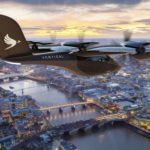A hydrogen-powered aircraft converted by Cranfield Aerospace Solutions’ (CAeS) could make its first commercial flights by 2025.
CAeS is leading a consortium backed by the UK government funding from the Aerospace Technology Institute to create a hydrogen propulsion system fuel cell system for a nine-seat Britten-Norman Islander which is currently being worked on in one of CAS’ hangars.
FINN spoke to chief strategy officer Jenny Kavanagh and CEO Paul Hunt the CEO to find out more about the project.
“The world’s first, truly green, certified aircraft for passenger service”
Kavanagh explained: “Essentially we’re going to be ripping out the conventional engines and replacing them with a fuel cell electric motor and gaseous hydrogen tanks. The end goal is to create the world’s first, truly green, certified aircraft for passenger service by 2025.”
The company has focused on hydrogen as opposed to full battery electric due to extend flight durations. “We…very quickly came to the conclusion that even with optimistic battery energy densities, you’re not going to get much more than 30 minutes flight time with this aircraft, which doesn’t even meet minimum diversion requirements,” added Kavanagh.
Hydrogen propulsion – better for revenue purposes
“We quickly went to hybrid electric, which could get the range and under certain circumstances even reduce carbon emissions. We, again, came to the realisation that for two very, very strong reasons that wasn’t going to cut it either: one being that utilisation is incredibly important to operators, especially the smaller ones, so the more sectors that you can get crammed into a day the better for revenue purposes.”
“If you’re having to recharge your batteries in between flights, that’s not going to work for them and, secondly if this industry is going to get to net zero by 2050, you have to just stop emitting carbon. Hydrogen very, very quickly became the only credible technology to consider.”
Britten-Norman Islander: “commercially viable” first aircraft
Paul Hunt explained the choice of aircraft for the project as “a very commercially viable first step”. He said the aircraft was well-liked by operators who typically used it for “short hops.” He added that the aircraft choice matched the maturity of the technology at the current point in time and described the project’s phased approach: “Once you’ve done that, the quickest way to get to commercial fair paying passengers in a fully certified zero emissions aircraft. We can then, in phase two of our programme, scale that up. At that point, that would probably be a 19-seat sized aircraft still fairly small, but scaling up the power requirement, but at the same time importantly moving to, most likely, liquid hydrogen to give the range needed that the larger aircraft are typically used for.”
choice matched the maturity of the technology at the current point in time and described the project’s phased approach: “Once you’ve done that, the quickest way to get to commercial fair paying passengers in a fully certified zero emissions aircraft. We can then, in phase two of our programme, scale that up. At that point, that would probably be a 19-seat sized aircraft still fairly small, but scaling up the power requirement, but at the same time importantly moving to, most likely, liquid hydrogen to give the range needed that the larger aircraft are typically used for.”
“By the end of phase two, we’ll have a propulsion system fully certified and that’s a technical, but manageable, challenge. Phase three, we can then say ‘Well now is the time to optimise an aircraft design,’ 19 seat, or around about that sort of size to wrap that optimized design around the certified propulsion system.”
Net zero ambitions – more likely to be achieved via conversions
Hunt said ambitions to achieve net zero by 2050 were more likely to be met through conversion of existing aircraft rather than redesigning new ones. He explained: “We feel that there’s an urgency to what needs to be done here in greening aviation. The quickest way is converting, we know that, we’ve been around for 30 years in the aerospace industry working with the regulator. We understand if you want to get things done quickly, if you go with a whole new aircraft and a whole new propulsion system, you’re creating a hugely complex hurdle to get over with the regulator, so speed
means go for a conversion. But, ultimately, to optimise the solution, you need to get both the propulsion system and the aircraft designed together and, from our point of view as a company,
aspiring to design and manufacture aircraft, it just makes sense to de-risk it and move it into stages.”
Certification and hydrogen supply will be among biggest challenges
One of the biggest challenges for the project will be certification, with the ambition of getting the aircraft ready to fly commercial passengers by 2025. Kavanagh said Cranfield had been dealing with regulators for nearly 30 years and knew that the approach would be to approach the issue with understanding of their issues. The project has been undertaken through an innovation hub. “Essentially we are having to learn along with them and to some extent they’re learning from us as well,” she added.
Getting hydrogen to aircraft operators in both remote parts of the UK and the rest of the world is likely to be another challenge, although Kavanagh explained the process would both power aviation and could power other industries. She said work to explore the benefits of hydrogen production was already ongoing in Scotland, the Isle of Wight, among other areas.
She explained: “I’m not going to say it’s simple, because any new fuel supply is not simple, but the beauty of green hydrogen, especially gaseous hydrogen, is that there is a relatively simple process by which you can have a wind turbine or solar panels and create renewable electricity that you can then convert into hydrogen “
“It has two-fold advantages: one, the hydrogen acts as a storage for any excess electricity that you can then use to turn back into electricity when you need it, or it can be used as a fuel for local ground transportation or indeed for aviation as well.”

